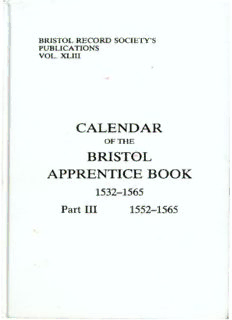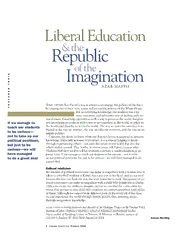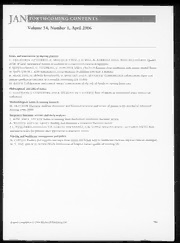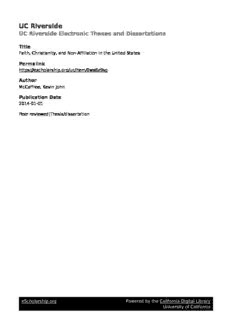
Faith, Christianity, and Non-Affiliation in the United States PDF
Preview Faith, Christianity, and Non-Affiliation in the United States
UC Riverside UC Riverside Electronic Theses and Dissertations Title Faith, Christianity, and Non-Affiliation in the United States Permalink https://escholarship.org/uc/item/0wx6z9sp Author McCaffree, Kevin John Publication Date 2014 Peer reviewed|Thesis/dissertation eScholarship.org Powered by the California Digital Library University of California UNIVERSITY OF CALIFORNIA RIVERSIDE Faith, Christianity, and Non-Affiliation in the United States A Dissertation submitted in partial satisfaction of the requirements for the degree of Doctor of Philosophy in Sociology by Kevin John McCaffree August 2014 Dissertation Committee Dr. Jan E. Stets, Chairperson Dr. Jonathan H. Turner Dr. Robert Nash Parker Dr. Alexandra Maryanski Dr. Michael Shermer Copyright by Kevin John McCaffree 2014 The Dissertation of Kevin John McCaffree is approved: ___________________________________________________________ ____________________________________________________________ Committee Chairperson University of California, Riverside ABSTRACT OF THE DISSERTATION Faith, Christianity, Non-Affiliation in the United States by Kevin John McCaffree Doctor of Philosophy, Graduate Program in Sociology University of California, Riverside, August 2014 Dr. Jan E. Stets, Chairperson Rates of religious non-affiliation continue to rise in the United States, with roughly 20% of Americans reporting no identification with any church or religious group. Generally, scholars have assumed these religious "nones" were atheists or agnostics with an active dislike of religious faith. This study explores the demographic, family background, political and moral worldview variation among a large sample of non-affiliates using various statistical regression analyses. Additionally, using a novel coding scheme, non- affiliates were modeled according to their self-reported levels of religiosity and spirituality, revealing further differentiation within this subpopulation. Results suggest that "nones" are not homogenously atheist or agnostic and that they likely vary in terms of their moral worldview and their political attitudes towards the family, among other things. iv Table of Contents General Introduction………………………………………………………………..… 1 Chapter 1: The Decoupling of Faith…………………………………………………...4 Data and Methods………………………………………………………..……23 Results………………………………………………………………………...32 Discussion…………………………………………………………………….37 References………………………………………………………………….…42 Tables…………………………………………………………………............49 Chapter 2: Political and Moral Worldview Differentiation within Christianity...........55 Data and Methods………………………………………………………….….69 Results………………………………………………………………………...79 Discussion…………………………………………………………………..…84 References………………………………………………………………….….89 Tables……………………………………………………………………….....95 Chapter 3: Religious Non-affiliation: Correlates and Manifestations…………......…100 Data and Methods, Study 1……………………………………………….….117 Results, Study 1…………………………………………………………........125 Discussion, Study 1……………………………………………………….….130 Data and Methods, Study 2…………………………………………….….…136 Results, Study 2………………………………………………………….…..140 Discussion, Study 2…………………………………………………………..143 General Discussion…………………………………………………………..145 References……………………………………………………………............151 Tables…………………………………………………………………...........157 General Conclusion……………………………………………………………..…....169 v List of Tables Table 1.1…………………………………………………………………………….49 Table 2.1…………………………………………………………………………….50 Table 3.1…………………………………………………………………………….51 Table 4.1…………………………………………………………………………….53 Table 1.2…………………………………………………………………………….95 Table 2.2…………………………………………………………………………….96 Table 3.2…………………………………………………………………………….97 Table 4.2…………………………………………………………………………….99 Table 1.3……………………………………………………………………………..157 Table 2.3……………………………………………………………………………..159 Table 3.3………………………………………………………………………….….160 Table 4.3………………………………………………………………………….….161 Table 5.3……………………………………………………………………………..163 Table 6.3……………………………………………………………………………..165 Table 7.3……………………………………………………………………………..166 Table 8.3…………………………………………………………………………......167 vi General Overview of the Study This is a large, general study of religiosity in the United States. It is both a study of fairly traditional subject matters (i.e., religious self-identification and religious affiliation), as well as a study of more novel issues such as religious non-affiliation. However, even when dealing with more traditional questions, this study attempts to pose new angles of examination at each turn. The dataset used for this study afforded the inclusion of several theoretically intriguing predictor variables, including measures of respondents’ family backgrounds (i.e., relationship with parents or family size) and their moral worldviews (i.e., how important God is for the establishment of moral principles). Overall this dissertation reveals a suite of variation among not only Christian affiliates, but also among non-affiliates or religious “nones,” using a novel coding strategy. There are three studies which form the heart of this dissertation. The first study is a seemingly unrelated regression predicting identification as highly religious or highly god-believing (henceforth “spirituality”). Two models are presented, one predicting levels of respondent religiosity (controlling for spirituality), and one predicting respondent levels of spirituality/belief in God (controlling for religiosity). Study 1 enables a fairly fine-grained analysis into the differences separating those who self- identify as religious as opposed to those who self-identify as primarily believing in a God or “higher power,” but who do not necessarily feel religious. Literature will be reviewed in Study 1 showing that past studies have found respondents to associate God-belief or spirituality with a more individualistic orientation to their faith (i.e., having a personal 1 relationship with God), whereas respondents who feel more religious tend to take a more communal approach to their faith (i.e., attending church). Thus, Study 1 constitutes an exploration into the possible demographic and attitudinal variation buried underneath self-reported religiosity or spirituality. Surprisingly few studies have asked this question, and results were very interesting. The second study of this dissertation treats Christian affiliation as the dependent variable, simply because the US is a predominantly Christian nation demographically. After isolating Christian affiliates in the sample, these respondents were subsequently coded into various denominations of Christian affiliation typically discussed in the literature, including Catholic, Mainline Protestant and Evangelical Protestant. Relative risk ratios are then derived using multi-nomial logistic regression, with Evangelicals as the baseline category. Results indeed show substantial variation among Christian affiliates, though some effects are more substantive—and surprising—than others. Lastly, Study 3 investigates religious non-affiliation. Both non-affiliates, as a general population, as well as specific “types” of religious non-affiliate are investigated. Religious non-affiliates were categorized based on their self-reported religiosity and spirituality/belief in God, so that demographic and attitudinal variation could be sought for. Very few studies have systematically investigated religious “nones,” and Study 3 adds to the literature by not only showing the viability of “typing” non-affiliates by their subjective religiosity/spirituality but by also showing that important demographic, political and moral worldview differences separate them. 2 Each subsequent chapter of this dissertation opens with an extensive literature review of past studies relevant to the present analysis. After this review of past studies, theoretically derived hypotheses are offered, though Study 3’s investigation of non- affiliates maintains an exploratory element. Next, the methods and analyses specific to each study are discussed, as each study uses a different statistical technique depending on the nature and measurement of the dependent variable. Lastly, a discussion follows each individual study, with Study 3 incorporating a general discussion of both non-affiliation as well as “types” of non-affiliate. 3
Description:The list of books you might like

Atomic Habits James Clear

Haunting Adeline

$100m Offers

The 5 Second Rule: Transform your Life, Work, and Confidence with Everyday Courage
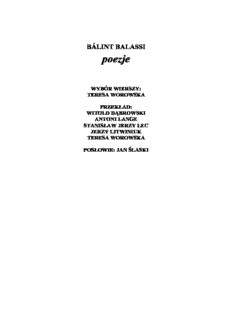
Bálint Balassi poezje
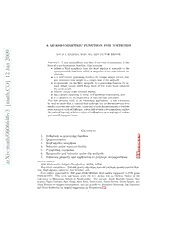
A quasisymmetric function for matroids
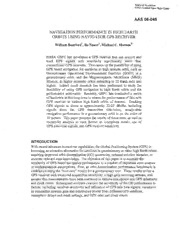
NAVIGATION PERFORMANCE IN HIGH EARTH ORBITS USING NAVIGATOR GPS RECEIVER

NASA Technical Reports Server (NTRS) 20060047744: Mated Flight Control Issues for Space Exploration Systems

Design of Observational Studies
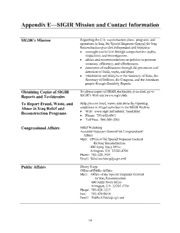
DTIC ADA545428: Department of State Contract to Study the Iraq Reconstruction Management System

TS 129 198-11 - V5.8.0 - Universal Mobile Telecommunications System (UMTS); Open Service Access (OSA) Application Programming Interface (API); Part 11: Account management Service Capability Feature (SCF) (3GPP TS 29.198-11 version 5.8.0 Release 5)
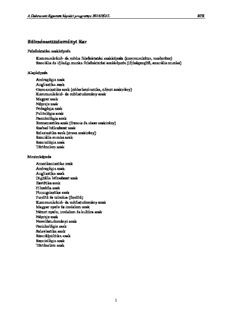
Bölcsészettudományi Kar
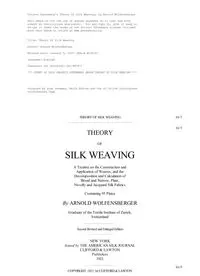
Theory of Silk Weaving
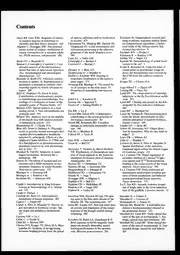
Journal of Comparative Physiology 1993: Vol 173 Table of Contents

Julio César. Un dictador democratico
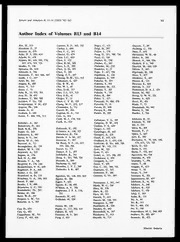
Sensors and Actuators, Part B: Chemical 1993: Vol B13-B14 Index
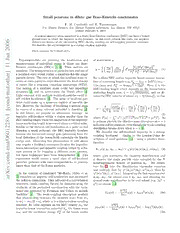
Small polarons in dilute gas Bose-Einstein condensates
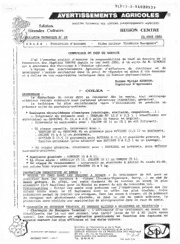
Avertissements Agricoles - Grandes cultures - Centre - 1993 - 24
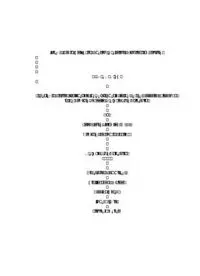
Lived Ethos in Norwegian America
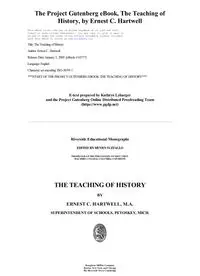
The Teaching of History by Ernest C Hartwell
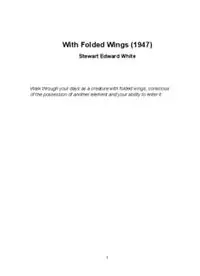
With Folded Wings (1947) - Conscious Living Foundation
